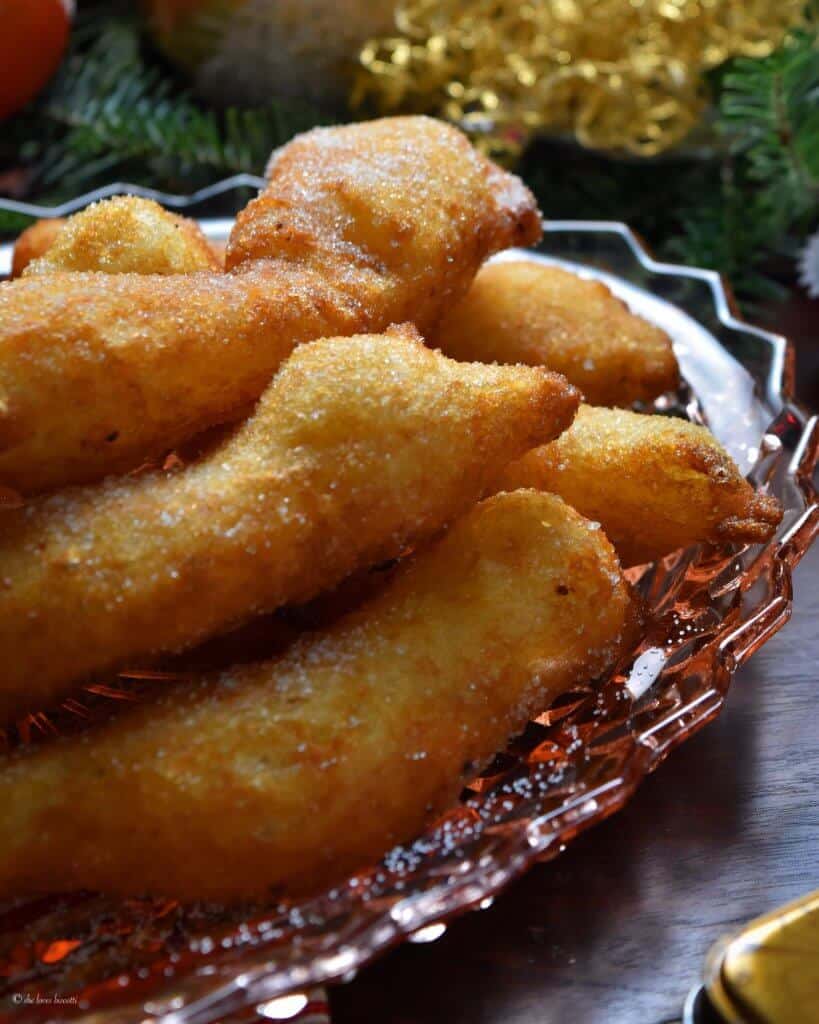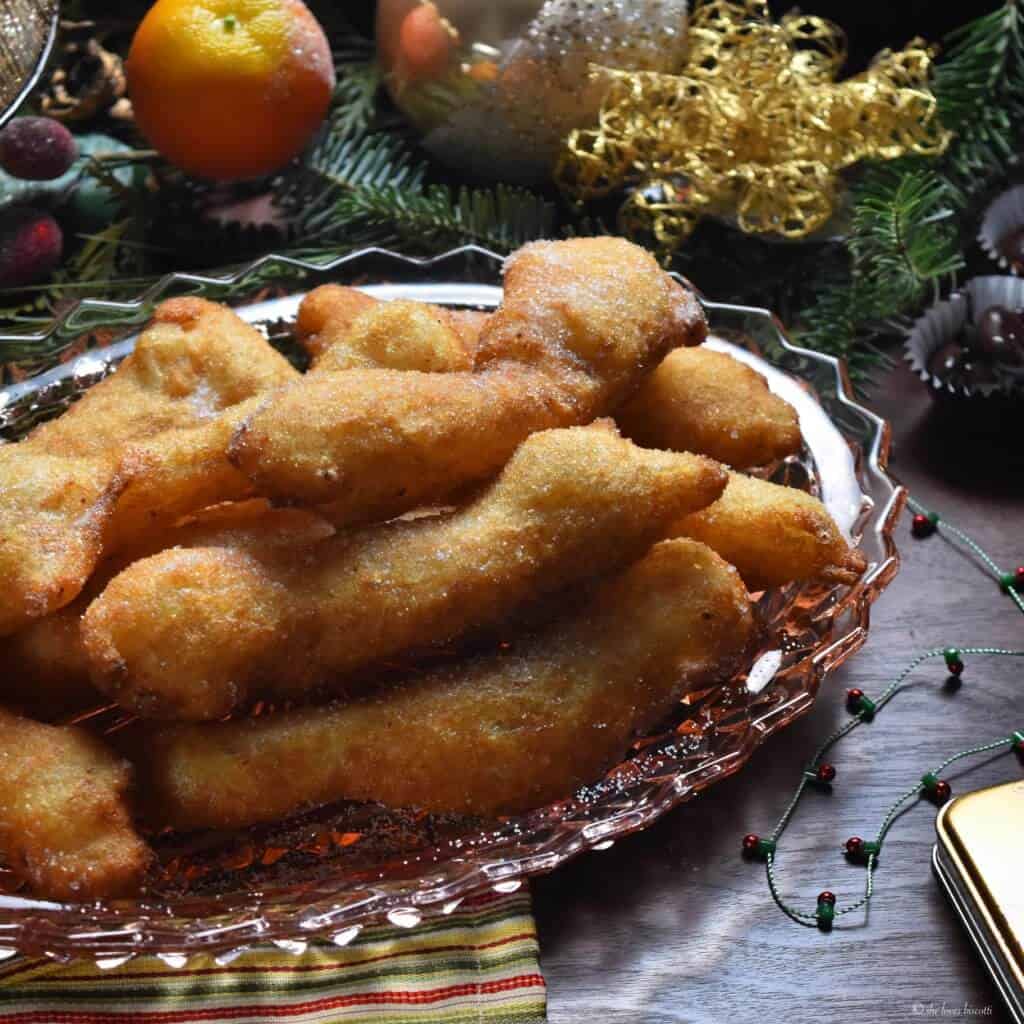Whether referred to as screppelle or Italian donuts, one this is for sure, this family recipe for these Traditional Molisani Christmas Eve Fritters is simply amazing. I would like to share one of my fondest food memories I have of growing up Italian and it takes the shape of a yeast donut made with potatoes.
I said time and again that I try to avoid fried foods whenever possible; usually I will try to replace frying with baking.
Being of Italian origin, there are a few exceptions to my “no fry” rule and it usually occurs around Christmas time.
One of these fried Italian cookies we love is Struffoli. You have probably heard of these being referred to as Italian Honey Balls. This is a no yeast dough that is formed into little balls and then deep fried for just a few minutes. As they are frying, they puff up to become light and crispy. They are then drenched in honey.
Another exception to my “no fry” rule are known as Crostoli. This is another no yeast dough that is rolled out paper thin and then fried. It literally takes just a few seconds for the dough to puff up. These fritters are then dusted with icing sugar. You have never tasted such a light and flaky dough!
Have you started drooling? I know I am…
Today, the focus will be on another one of my exceptions which I refer to as Screppelle, which are basically Italian donuts.
Growing up Italian meant so many things to me, and one of the best things about my Italian family was all the get-togethers during the holidays. In preparation for Christmas, my mom and nonna would make these delicious screppelle. They are great when they are fresh, but don’t keep especially well, so there was always a mad-rush on Christmas Eve morning, trying to get everything done.
I cannot even begin to describe how delicious these fritters are right when they cool down. The first bite you take has them being still warm and all rolled around in granulated sugar… yum!
I can’t wait to share this family recipe with you…
How to make Italian donuts
The whole process begins with some magical yeast. Proof the yeast according to the packet directions.
Then, mix all the ingredients together: the yeast, flour, salt, and – wait for it! – the boiled/mashed potatoes. Yes, potatoes! It may seem weird, but trust me on this one. 🙂 You’ll need some warm water for this recipe, too – I provide an amount in the recipe below, but really, you only need as much water as “is needed”, cryptic as that sounds.
My mom and grandma never actually measured out ingredients, but instead gained so much experience in making certain recipes over and over again that they would add ingredients “by eye”… they knew what consistency they wanted the dough to be, in the end, and added ingredients until it reached that consistency. Even I don’t have enough experience to make these without measurements though – it takes years of practice!
Anyway, the resultant dough should be smooth, elastic and sticky. Don’t even try to shape it into a ball. Just cover and let it rise for a couple of hours or until double in size.
Once the dough is ready, it will soon need to be deep-fried, so start heating up your oil. Nowadays, most Italians (that I know) will use all-purpose vegetable oil for this recipe, but some say that that leaves a bit of an aftertaste. You can use canola oil, or peanut oil, if you’d like to avoid that. You should also prepare a large plate, lined with paper towels – you’ll need it later.
Now, the fun part! Rub some vegetable oil on your hands, and then pick up some dough in your fingers, about the size of a golf-ball. It will be sticky and gloopy – a throwback to those papier maché projects of yore. 😉
Stretch the dough out in your hands, and drop it carefully in the oil. Be careful not to splash! Do this for 3 or so pieces of dough. The dough should float in the oil.
Then, with two forks, one in each hand, turn the fritters over and over again while they are in the oil, so that they fry evenly. When they achieve a light golden color, remove them from the oil, and place on the plate lined with paper towels. Repeat until there is no dough left, but don’t forget to thoroughly coat the fritters in granulated sugar while they are still somewhat warm! My mom used to toss them with sugar, but I prefer sprinkling them with sugar.
Time is of the essence with this recipe, so I find it most efficient to do this with two people. One person scoops out and shapes the fritters, and drops them into the oil; the other person turns the fritters constantly, and sprinkled them with sugar. I used to help my mom when she would make them, but ever since she passed away, the torch has been passed on to my daughter and I.
Recipe source
Ever since I can remember, these fritters would be made on the morning of Christmas Eve Day.
In the dialect of my paternal grandmother, we would refer to them as scr’pell -which would be spelled as screppelle.
This is an old family recipe with its origins from Ripabottoni, in the province of Campobasso, in the Italian region of Molise.
The dough would be made in the early morning hours and fried in batches just in time for lunch, which consisted of this Saint Joseph’s Day Spaghetti Recipe (made twice in the year; once for Christmas Eve lunch and once on March 19th) and baccala (salt cod) with potatoes. These screppele would be part of the Christmas dessert line-up, along with an endless assortment of cakes and cookies.
I can still envision my paternal grandmother and my mom making this yearly treat. My grandmother would be the one meticulously shaping and dropping the dough in the hot oil; my mom was responsible for making sure they were fried to a golden perfection.
You will probably find all shapes and sizes when it comes to these fritters, and today there are all kinds of variations. The recipe I am sharing with you today is the one that I grew up with – a simple potato yeast fritter, shaped into a 4-5 inch log-like shape.
After my grandmother passed away, the lead was taken by my mom. When I was not working, I would be the official helper, otherwise, this role was assumed (somewhat clumsily) by my Dad.
The tradition continues; now I take charge of this recipe, helped by my husband.
It never ceases to amaze me how certain foods have the power to bring us back in time and elicit so many wonderful memories.
For my dear family, friends and all of you that are celebrating Christmas, I would like to wish you and your loved ones a very Merry Christmas. And for those not celebrating Christmas, I hope the weekend is full of love, happiness and some wonderful moments!
Buon Natale a tutti ♥
Recipe

Traditional Molisani Christmas Eve Fritters
Ingredients
- 2¼ teaspoons active dry yeast 8 grams
- 1 teaspoon sugar
- ¼ cup lukewarm water
- 4 cups all purpose flour 568 grams
- 1 teaspoon salt
- 2 medium potatoes boiled and riced (about 225 grams or 1 cup)
- 1½ cups lukewarm water
for frying:
- 3-4 cups vegetable oil or canola
for garnish:
- granulated table sugar
Instructions
- In a small bowl, combine yeast, sugar and water.
- Stir and let stand for 10 minutes (will get foamy).
- Meanwhile, in the bowl of a stand mixer, combine the flour, salt, mashed potato, and water with the dough hook.
- Add the yeast mixture and knead for about 10 minutes. Please note that the dough will be extremely soft.
- Cover and allow to double in size. This will take about 2 hours.
- When the dough is ready, heat up the oil for deep frying (375°F)
- Stretch a piece of dough about the size of a golf ball and drop it in the oil.
- When they achieve a light golden color, remove them from the oil, and place on the plate lined with paper towels. This should take 1-2 minutes.
- Repeat until there is no dough left.
- Sprinkle with granulated sugar while the fritters are warm.
- These fritters are best the day they are fried.
Video
Notes
Nutrition








Adela Belcastro
Thank you, Maria. This is the only recipe of Mum’s that I never learned.
I have missed it so much until now! Thank you for helping to remedy a very sizeable regret. My childhood memory is now deliciously intact. Grazie!
Maria
Food memories are the best ♥ It is truly my pleasure. Thanks so much for stopping by Adela!
Diane Catalano Rodriguez
In Calabria these are called “Cularelli” and we ate them every Christmas Eve along side fish or bacallà , to represent the fishes and loaves. Ours were in an oval ring shape, each ring about 6” long.
Irene Digiacomo
Oh and my dad was from campobasso
Thanks for keeping these recipes alive!! We called them buttatil pronounced buttateel mom was from bagnoli del trignio and dad was from shat now is provincial inertia thanks!!
Frances Doria
My oh my!!! These are the same recipe my mom made (She passed this past September) and they are called “crespelle” in Frosinone. I believe the dialect just changed a bit, as we are not far from Molise. I have been making them with mom for many years, and hope to continue to do so with my daughters & daughters-in-law!!
Maria
I am so sorry for your loss Frances.
How wonderful for you to keep these wonderful family traditions with the next generation! Buon Natale to you and your loved ones!
Irene D.
In bagnioli del trignio
These are calked buttatil pronounced butateel
Scerpelle are like crostole but fluffier but this is how my mom and aunties made buttatil essentially fried donuts sooo good I think every little town has there own name
Anna DiTrapano
Thank you Maria for the recipe. I come from Italy actually in Abbruzzo. My mother would always make these crispelle that’s how we call them in Abbruzzo on Christmas eve and I always watch her when she made them. We didn’t have a machine to make the dough so she would beat the dough by hand, after it proofed for a couple of hours she would then put a black iron frying pan on top of coals in our fireplace and start frying them. I could not wait the taste them, sometimes she would put raisins in them if she had them. I’m going to try your recipe since it sounds just like my mom used to make. Have a Blessed Christmas Maria to you and your family.
Maria
Thank you so much for sharing Anna! There was so much love in everything that generation did ♥
Wishing you and your loved ones a blessed Christmas as well, thank you!
Joanne
My grandmother made these every Easter and Christmas… always looked forward to them. She had to double the recipe because we worked eat half while she was making them. We also called them Scrupelli, from a small village called Vinchiaturro near Campobasso.
Maria
Great memories ♥ They are sooo good when they are freshly made! Thanks for stopping by Joanne!
dan coccia
my dad came from abbruzzo province. he was born in 1907 and came to america in 1920. i too rmember these tasty gems my mother used to make and would give anything to taste hers again.
Maria
These truly are the best! Sending you hugs Dan ♥
Ann Marie Viggiano
My mother’s mother would make these only about 3 inches long and soak them in honey. She would cover the huge bowl with a towel and “hide” them on top of an armoire. One year my brother (who was very tall) found them…we ate alot of them. When she discovered this—Oh the screaming and waving of the wooden spoon and laughing (and cursing in Italian!!) Of course she made more, all the while threatening us by waving that wooden spoon at us….Ah, Grandma Louisa!!
Maria
What a wonderful food memory! Thank you so much for sharing Ann Marie ♥
Frances Doria
Love the wooden spoon!!!!
dan coccia
ah the famous wooded spoon; AKA the italian attitude adjuster !!
Clara Lalli Dirienzocldirienzo@att.net
I’m from Vastogirardi Pro, di Isernia I lost my mother’s receipt and I can’t believe when I found this receipt! You made my day , my family is going to be so happy and my parents in heaven are going to be smiling down at us . Clara❤️
Maria
I am so thrilled to read this! Buon Natale Clara ♥
Mary
My mother made these every Christmas Eve but she never wrote the recipe down. I watched her make it many times. I have made them for my family ever year and they came out great. But am happy to see a recipe written out. Am going to use it this Christmas and see how it compares. It is nice to have a name and recipe to pass on down to next generation. Thank you!
Maria
My pleasure Mary! Buon Natale!
Nick Sarro
I make something VERY similar to this – especially for Christmas eve. I do not use potatoes – . But in essence – I don’t have a recipe as I know by the consistency – it is flour, some salt, yeast (warm water, sugar to let of the yeast poof), instead the liquid for the dough is ROSEMARY tea – gives it more flavor. After frying and ‘draining’ – place is a plastic bag with powdered sugar and shake). These go faster than I can make them!!
Maria
Sounds delicious Nick! Thanks so much for sharing!
Giovanna Sassi
You made me so happy…I miss these!
Maria
Such a wonderful treat! Thanks Giovanna!
Elle
Very tender and relatively easy. The dough was a dream to work with. I added a 3/4 of a cup of raisins. Beautiful results. I coated them in superfine sugar. Enjoyed by everyone – young and old.
Maria
So happy to read this, thanks so much for sharing Elle!
Angela
Great recipe! My mother-in-law makes these every Christmas Eve and they’re delicious! She doesn’t sprinkle sugar instead she places an anchovy inside the ball and fries it.
Maria
Thanks Angela! That is how my maternal grandmother would make them! So many wonderful traditions! Thanks for sharing.